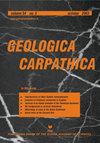从底栖有孔虫的角度考察Pienin-Klippen带(西喀尔巴阡山脉)侏罗纪珊瑚生物礁的时代
IF 1.5
4区 地球科学
Q4 GEOSCIENCES, MULTIDISCIPLINARY
引用次数: 3
摘要
摘要Vršatec石灰岩的珊瑚生物礁在侏罗纪期间形成了数十米厚的大型复合体,是碳酸盐岩生产的重要来源,碳酸盐沉积物被输出到Pieniny Klippen盆地(西喀尔巴阡山脉)的更深部分。然而,这些碳酸盐工厂的年代仍然存在争议。对Pienin-Klippen带西部五个地点(Vršatec Castle、Vrçatec Javorníky、MaléHradište、MalèHradičte Kalvária和DrieńováHora)的Vrš和角砾岩,与之前的研究表明它们是在牛津阶沉积的相反。首先,根据存在-不存在数据,所有地点的有孔虫组合组成相似,尽管Vršatec的生物相有孔虫群落以粟粒岩为主,而MaléHradište的生物批评相以spirillinid Paalzowella为主。Vršatec石灰岩下部和上部的有孔虫组合组成没有差异。其次,假设首次出现在牛津阶的有孔虫物种已经出现在德提斯大陆架北部侏罗纪中期的沉积物中。第三,在其他特提斯地区记录的有孔虫的首次和最后一次出现与地层分析和菊石的出现相一致,表明在巴焦阶期间,Czorzstyn山脊上形成了生物礁的珊瑚群落。Vršatec石灰岩中的几种有孔虫首次出现在阿勒期中期或晚期(Labalina occluta、Paalzowella feifeli)和巴乔期(Hungarillina lokutiense、Radiospirillina umbonata、Ophthalmicium caucasicum、O.terquemi、O.obscum、Paalzowella turbinella、Cornupira tubicomprimata、Nubecularia reicheli),或最后一次出现在Bajocian(Tethysiella pileri)或Early Bathonian(Ophthalmicium caucasicum,O.obscum)。Vršatec石灰岩的底栖有孔虫群落的组成和多样性与巴乔阶期间法国汝拉和勃艮第的碳酸盐岩平台环境中的有孔虫珊瑚群落的组成相似。本文章由计算机程序翻译,如有差异,请以英文原文为准。
Revisiting the Age of Jurassic Coral Bioherms in the Pieniny Klippen Belt (Western Carpathians) on the Basis of Benthic Foraminifers
Abstract Coral bioherms of the Vršatec Limestone that formed massive, several tens of meters thick complexes during the Jurassic were important sources of carbonate production, with carbonate sediment exported to deeper parts of the Pieniny Klippen Basin (Western Carpathians). However, the age of these carbonate factories remains controversial. New analyses of benthic foraminiferal assemblages occurring in coral bioherms and peri-biohermal deposits of the Vršatec Limestone at five sites in the western Pieniny Klippen Belt (Vršatec-Castle, Vršatec-Javorníky, Malé Hradište, Malé Hradište-Kalvária, and Drieňová Hora) show that these sediments were deposited during the Bajocian and were lateral equivalents of crinoidal limestones and breccias, in contrast to previous studies suggesting that they were deposited during the Oxfordian. First, all sites are characterized by similar composition of foraminiferal assemblages on the basis of presence–absence data, although foraminiferal assemblages in biosparitic facies at Vršatec are dominated by miliolids whereas biomicritic facies at Malé Hradište are dominated by the spirillinid Paalzowella. The composition of foraminiferal assemblages does not differ between the lower and upper parts of the Vršatec Limestone. Second, foraminifer species that were assumed to appear for the first time in the Oxfordian already occur in the Middle Jurassic sediments of the northern Tethyan shelf. Third, the first and last appearances of foraminifers documented in other Tethyan regions are in accordance with stratigraphic analyses and ammonoid occurrences, demonstrating that bioherm-forming coral communities developed on the Czorzstyn Ridge during the Bajocian. Several species of foraminifers of the Vršatec Limestone appeared for the first time during the middle or late Aalenian (Labalina occulta, Paalzowella feifeli) and during the Bajocian (Hungarillina lokutiense, Radiospirillina umbonata, Ophthalmidium caucasicum, O. terquemi, O. obscurum, Paalzowella turbinella, Cornuspira tubicomprimata, Nubecularia reicheli) or appeared for the last time in the Bajocian (Tethysiella pilleri) or Early Bathonian (Ophthalmidium caucasicum, O. obscurum). The composition and diversity of communities with benthic foraminifers of the Vršatec Limestone is similar to the composition of foraminiferal communities on carbonate platform environments with corals of the French Jura and Burgundy during the Bajocian.
求助全文
通过发布文献求助,成功后即可免费获取论文全文。
去求助
来源期刊

Geologica Carpathica
地学-地球科学综合
CiteScore
2.40
自引率
23.10%
发文量
26
审稿时长
>12 weeks
期刊介绍:
GEOLOGICA CARPATHICA covers a wide spectrum of geological disciplines including geodynamics, tectonics and structural geology, volcanology, stratigraphy, geochronology and isotopic geology, karstology, geochemistry, mineralogy, petrology, lithology and sedimentology, paleogeography, paleoecology, paleobiology and paleontology, paleomagnetism, magnetostratigraphy and other branches of applied geophysics, economic and environmental geology, experimental and theoretical geoscientific studies. Geologica Carpathica , with its 60 year old tradition, presents high-quality research papers devoted to all aspects not only of the Alpine-Carpathian-Balkanian geoscience but also with adjacent regions originated from the Mediterranean Tethys and its continental foreland. Geologica Carpathica is an Official Journal of the Carpathian-Balkan Geological Association.
 求助内容:
求助内容: 应助结果提醒方式:
应助结果提醒方式:


